Identification of Potential Landslides in the Gaizi Valley Section of the Karakorum Highway Coupled with TS-InSAR and Landslide Susceptibility Analysis
Abstract
:1. Introduction
2. Materials and Methods
2.1. Research Area
2.2. Materials
2.2.1. Historical Landslide Datasets
2.2.2. Selection of Indicators for Landslide Susceptibility Assessment
2.2.3. SAR Data and Interference Pair Information
2.3. Methods
2.3.1. Technical Process
2.3.2. Landslide Susceptibility Assessment Methodology
2.3.3. TS-InSAR Technology
- SBAS-InSAR Principle
- DS-InSAR Principle
- (1)
- Homogeneous image recognition. The study used an amplitude-based t-hypothesis approach to identify statistically homogeneous pixels (SHPs) [50]. Pixels with more connected SHPs than a threshold value of 20 can be regarded as distributed target candidates (DSCs) in the subsequent phase optimization operation [51,52]. The original hypothesis and alternative hypotheses of the two-sample t-hypothesis test are as follows:where and are the mean values of the SAR image amplitudes in the two samples, and the test statistics of the samples are expressed as follows:where t is the test statistic of the sample, which obeys the t-distribution; and are the two image elements to be tested; is the mean value of the sample amplitude of the image element; and are the sample amplitude variances of the image elements and ; and N denotes the sample capacity.
- (2)
- Phase optimization. Assuming that n is the number of SAR images and l is the number of homogeneous pixels, the complex coherence matrix can be calculated via Equation (8).where is the paradigm operation performed on the matrix rows, T is the sample complex coherence matrix, Z is the n × l homogeneous image matrix, and is its transpose matrix. In this study, phase optimization is achieved via an interferometric phase maximum likelihood estimation (EMI) [53] method that is based on feature decomposition. The computational formula is as follows:where Г is the coherence matrix, is the optimized phase, is the reciprocal of the optimized phase, and and are scale parameters that provide additional degrees of freedom for the calibration of Г. Linearizing in Equation (9) with a Taylor series and adding a paradigm constraint on via Lagrange multipliers, the equation to be solved is thus transformed toEquation (10) can be used to find the eigenvector corresponding to the smallest eigenvalue via eigen decomposition, and the phase of the original image element can be replaced with the phase of the eigenvector to achieve phase optimization. After the DS and PS targets are selected and fused by setting the threshold value of the temporal coherence coefficient, phase untangling and error correction, such as atmospheric delay, are completed according to the basic flow of temporal InSAR data processing, and finally, the deformation information of the study area is obtained.
2.3.4. Potential Landslide Identification and Analysis
3. Results
3.1. Deformation Results
3.2. Landslide Susceptibility Results
3.3. Potential Landslide Identification
3.4. Potential Landslide Analysis and Validation
4. Discussion
4.1. Strengths and Weaknesses of Dual-Orbit Time-Series InSAR Monitoring of Potential Landslides
4.2. Natural Factors Interfere with Potential Landslide Identification
4.3. Identification of Potential Landslides Disturbed by Engineering Activities
5. Conclusions
Author Contributions
Funding
Data Availability Statement
Acknowledgments
Conflicts of Interest
References
- Tehrani, F.S.; Calvello, M.; Liu, Z.; Zhang, L.; Lacasse, S. Machine Learning and Landslide Studies: Recent Advances and Applications. Nat. Hazards 2022, 114, 1197–1245. [Google Scholar] [CrossRef]
- Chae, B.-G.; Park, H.-J.; Catani, F.; Simoni, A.; Berti, M. Landslide Prediction, Monitoring and Early Warning: A Concise Review of State-of-the-Art. Geosci. J. 2017, 21, 1033–1070. [Google Scholar] [CrossRef]
- Froude, M.J.; Petley, D.N. Global Fatal Landslide Occurrence from 2004 to 2016. Nat. Hazards Earth Syst. Sci. 2018, 18, 2161–2181. [Google Scholar] [CrossRef]
- Dilley, M. Natural Disaster Hotspots: A Global Risk Analysis; Disaster Risk Management Series; World Bank: Washington, DC, USA, 2005; ISBN 978-0-8213-5930-3. [Google Scholar]
- Sassa, K.; Canuti, P.; International Consortium on Landslides (Eds.) Landslides: Disaster Risk Reduction; Springer: Berlin/Heidelberg, Germany, 2009; ISBN 978-3-540-69966-8. [Google Scholar]
- Thi Ngo, P.T.; Panahi, M.; Khosravi, K.; Ghorbanzadeh, O.; Kariminejad, N.; Cerda, A.; Lee, S. Evaluation of Deep Learning Algorithms for National Scale Landslide Susceptibility Mapping of Iran. Geosci. Front. 2021, 12, 505–519. [Google Scholar] [CrossRef]
- Mantovani, J.R.; Bueno, G.T.; Alcântara, E.; Park, E.; Cunha, A.P.; Londe, L.; Massi, K.; Marengo, J.A. Novel Landslide Susceptibility Mapping Based on Multi-Criteria Decision-Making in Ouro Preto, Brazil. J. Geovis. Spat. Anal. 2023, 7, 7. [Google Scholar] [CrossRef]
- Pradhan, B.; Dikshit, A.; Lee, S.; Kim, H. An Explainable AI (XAI) Model for Landslide Susceptibility Modeling. Appl. Soft Comput. 2023, 142, 110324. [Google Scholar] [CrossRef]
- Dou, J.; Yunus, A.P.; Bui, D.T.; Merghadi, A.; Sahana, M.; Zhu, Z.; Chen, C.-W.; Han, Z.; Pham, B.T. Improved Landslide Assessment Using Support Vector Machine with Bagging, Boosting, and Stacking Ensemble Machine Learning Framework in a Mountainous Watershed, Japan. Landslides 2020, 17, 641–658. [Google Scholar] [CrossRef]
- Wu, X.; Song, Y.; Chen, W.; Kang, G.; Qu, R.; Wang, Z.; Wang, J.; Lv, P.; Chen, H. Analysis of Geological Hazard Susceptibility of Landslides in Muli County Based on Random Forest Algorithm. Sustainability 2023, 15, 4328. [Google Scholar] [CrossRef]
- Wang, H.; Zhang, L.; Luo, H.; He, J.; Cheung, R.W.M. AI-Powered Landslide Susceptibility Assessment in Hong Kong. Eng. Geol. 2021, 288, 106103. [Google Scholar] [CrossRef]
- Jiaxuan, H.; Mowen, X.; Atkinson, P.M. Dynamic Susceptibility Mapping of Slow-Moving Landslides Using PSInSAR. Int. J. Remote Sens. 2020, 41, 7509–7529. [Google Scholar] [CrossRef]
- Lu, P.; Shi, W.; Wang, Q.; Li, Z.; Qin, Y.; Fan, X. Co-Seismic Landslide Mapping Using Sentinel-2 10-m Fused NIR Narrow, Red-Edge, and SWIR Bands. Landslides 2021, 18, 2017–2037. [Google Scholar] [CrossRef]
- Yao, W.; Li, C.; Zhan, H.; Zhou, J.-Q.; Criss, R.E.; Xiong, S.; Jiang, X. Multiscale Study of Physical and Mechanical Properties of Sandstone in Three Gorges Reservoir Region Subjected to Cyclic Wetting–Drying of Yangtze River Water. Rock Mech. Rock Eng. 2020, 53, 2215–2231. [Google Scholar] [CrossRef]
- Shahabi, H.; Rahimzad, M.; Tavakkoli Piralilou, S.; Ghorbanzadeh, O.; Homayouni, S.; Blaschke, T.; Lim, S.; Ghamisi, P. Unsupervised Deep Learning for Landslide Detection from Multispectral Sentinel-2 Imagery. Remote Sens. 2021, 13, 4698. [Google Scholar] [CrossRef]
- Li, S.; Xu, W.; Li, Z. Review of the SBAS InSAR Time-Series Algorithms, Applications, and Challenges. Geod. Geodyn. 2022, 13, 114–126. [Google Scholar] [CrossRef]
- Liu, X.; Zhao, C.; Zhang, Q.; Lu, Z.; Li, Z.; Yang, C.; Zhu, W.; Liu-Zeng, J.; Chen, L.; Liu, C. Integration of Sentinel-1 and ALOS/PALSAR-2 SAR Datasets for Mapping Active Landslides along the Jinsha River Corridor, China. Eng. Geol. 2021, 284, 106033. [Google Scholar] [CrossRef]
- Intrieri, E.; Raspini, F.; Fumagalli, A.; Lu, P.; Del Conte, S.; Farina, P.; Allievi, J.; Ferretti, A.; Casagli, N. The Maoxian Landslide as Seen from Space: Detecting Precursors of Failure with Sentinel-1 Data. Landslides 2018, 15, 123–133. [Google Scholar] [CrossRef]
- Liu, M.; Yang, W.; Yang, Y.; Guo, L.; Shi, P. Identify Landslide Precursors from Time Series InSAR Results. Int. J. Disaster Risk Sci. 2023, 14, 963–978. [Google Scholar] [CrossRef]
- Rosi, A.; Tofani, V.; Tanteri, L.; Tacconi Stefanelli, C.; Agostini, A.; Catani, F.; Casagli, N. The New Landslide Inventory of Tuscany (Italy) Updated with PS-InSAR: Geomorphological Features and Landslide Distribution. Landslides 2018, 15, 5–19. [Google Scholar] [CrossRef]
- Dai, K.; Feng, Y.; Zhuo, G.; Tie, Y.; Deng, J.; Balz, T.; Li, Z. Applicability Analysis of Potential Landslide Identification by InSAR in Alpine-Canyon Terrain—Case Study on Yalong River. IEEE J. Sel. Top. Appl. Earth Obs. Remote Sens. 2022, 15, 2110–2118. [Google Scholar] [CrossRef]
- Ran, P.; Li, S.; Zhuo, G.; Wang, X.; Meng, M.; Liu, L.; Chen, Y.; Huang, H.; Ye, Y.; Lei, X. Early Identification and Influencing Factors Analysis of Active Landslides in Mountainous Areas of Southwest China Using SBAS-InSAR. Sustainability 2023, 15, 4366. [Google Scholar] [CrossRef]
- Dai, C.; Li, W.; Wang, D.; Lu, H.; Xu, Q.; Jian, J. Active Landslide Detection Based on Sentinel-1 Data and InSAR Technology in Zhouqu County, Gansu Province, Northwest China. J. Earth Sci. 2021, 32, 1092–1103. [Google Scholar] [CrossRef]
- He, Y.; Wang, W.; Zhang, L.; Chen, Y.; Chen, Y.; Chen, B.; He, X.; Zhao, Z. An Identification Method of Potential Landslide Zones Using InSAR Data and Landslide Susceptibility. Geomat. Nat. Hazards Risk 2023, 14, 2185120. [Google Scholar] [CrossRef]
- Zhao, F.; Meng, X.; Zhang, Y.; Chen, G.; Su, X.; Yue, D. Landslide Susceptibility Mapping of Karakorum Highway Combined with the Application of SBAS-InSAR Technology. Sensors 2019, 19, 2685. [Google Scholar] [CrossRef]
- Wei, Y.; Qiu, H.; Liu, Z.; Huangfu, W.; Zhu, Y.; Liu, Y.; Yang, D.; Kamp, U. Refined and Dynamic Susceptibility Assessment of Landslides Using InSAR and Machine Learning Models. Geosci. Front. 2024, 15, 101890. [Google Scholar] [CrossRef]
- Ahmed, M.F.; Rogers, J.D.; Bakar, M.Z.A. Hunza River Watershed Landslide and Related Features Inventory Mapping. Env. Earth Sci. 2016, 75, 523. [Google Scholar] [CrossRef]
- Rehman, M.U.; Zhang, Y.; Meng, X.; Su, X.; Catani, F.; Rehman, G.; Yue, D.; Khalid, Z.; Ahmad, S.; Ahmad, I. Analysis of Landslide Movements Using Interferometric Synthetic Aperture Radar: A Case Study in Hunza-Nagar Valley, Pakistan. Remote Sens. 2020, 12, 2054. [Google Scholar] [CrossRef]
- Zhao, F.; Zhang, Y.; Meng, X.; Su, X.; Shi, W. Early identification of geological hazards in the Gaizi valley near the Karakoran Highway based on SBAS-InSAR technology. Hydrogeol. Eng. Geol. 2020, 47, 142–152. [Google Scholar] [CrossRef]
- Wang, Y.; Tang, L.; Wang, X.; Zhou, Z.; Li, Z.; Li, C. Land surface deformation analysis based on time series InSAR technologies in the Gaizi valley section of China-Pakistan Corridor. J. Univ. Chin. Acad. Sci. 2022, 39, 343–351. [Google Scholar] [CrossRef]
- Su, X.; Meng, X.; Zhang, Y.; Yue, D.; Zhou, Z.; Guo, F. Progress in and prospects of study on geohazards in the ChinaPakistan Economic Corridor. J. Lanzhou Univ. (Nat. Sci.) 2023, 59, 694–710. [Google Scholar] [CrossRef]
- Jiang, N.; Su, F.; Li, Y.; Guo, X.; Zhang, J.; Liu, X. Debris Flow Assessment in the Gaizi-Bulunkou Section of Karakoram Highway. Front. Earth Sci. 2021, 9, 660579. [Google Scholar] [CrossRef]
- Yi, X.; Shang, Y.; Shao, P.; Meng, H. A dataset of spatial distributions and attributes of typical rockfalls and landslides in the China-Pakistan Economic Corridor from 1970 to 2020. China Sci. Data 2021, 6, 5–14. [Google Scholar] [CrossRef]
- Huang, F.; Xiong, H.; Yao, C.; Catani, F.; Zhou, C.; Huang, J. Uncertainties of Landslide Susceptibility Prediction Considering Different Landslide Types. J. Rock Mech. Geotech. Eng. 2023, 15, 2954–2972. [Google Scholar] [CrossRef]
- He, L.; Wu, X.; He, Z.; Xue, D.; Luo, F.; Bai, W.; Kang, G.; Chen, X.; Zhang, Y. Susceptibility Assessment of Landslides in the Loess Plateau Based on Machine Learning Models: A Case Study of Xining City. Sustainability 2023, 15, 14761. [Google Scholar] [CrossRef]
- Ducea, M.N.; Lutkov, V.; Minaev, V.T.; Hacker, B.; Ratschbacher, L.; Luffi, P.; Schwab, M.; Gehrels, G.E.; McWilliams, M.; Vervoort, J.; et al. Building the Pamirs: The View from the Underside. Geol 2003, 31, 849. [Google Scholar] [CrossRef]
- He, S.; Pan, P.; Dai, L.; Wang, H.; Liu, J. Application of Kernel-Based Fisher Discriminant Analysis to Map Landslide Susceptibility in the Qinggan River Delta, Three Gorges, China. Geomorphology 2012, 171–172, 30–41. [Google Scholar] [CrossRef]
- Chen, F.; Cai, C.; Li, X.; Sun, T.; Qian, Q. Evaluation of landslide susceptibility based on information volume and neural network model. Chin. J. Rock Mech. Eng. 2020, 39, 2859–2870. [Google Scholar] [CrossRef]
- Yu, C.; Li, Z.; Penna, N.T.; Crippa, P. Generic Atmospheric Correction Model for Interferometric Synthetic Aperture Radar Observations. JGR Solid Earth 2018, 123, 9202–9222. [Google Scholar] [CrossRef]
- Yu, C.; Li, Z.; Penna, N.T. Interferometric Synthetic Aperture Radar Atmospheric Correction Using a GPS-Based Iterative Tropospheric Decomposition Model. Remote Sens. Environ. 2018, 204, 109–121. [Google Scholar] [CrossRef]
- Yu, C.; Penna, N.T.; Li, Z. Generation of Real-time Mode High-resolution Water Vapor Fields from GPS Observations. JGR Atmos. 2017, 122, 2008–2025. [Google Scholar] [CrossRef]
- El Jazouli, A.; Barakat, A.; Khellouk, R. GIS-Multicriteria Evaluation Using AHP for Landslide Susceptibility Mapping in Oum Er Rbia High Basin (Morocco). Geoenviron. Disasters 2019, 6, 3. [Google Scholar] [CrossRef]
- Bathrellos, G.D.; Skilodimou, H.D.; Zygouri, V.; Koukouvelas, I.K. Landslide: A Recurrent Phenomenon? Landslide Hazard Assessment in Mountainous Areas of Central Greece. ZFG 2021, 63, 95–114. [Google Scholar] [CrossRef]
- Zou, F.; Che, E.; Long, M. Quantitative Assessment of Geological Hazard Risk with Different Hazard Indexes in Mountainous Areas. J. Clean. Prod. 2023, 413, 137467. [Google Scholar] [CrossRef]
- Youssef, A.M.; El-Haddad, B.A.; Skilodimou, H.D.; Bathrellos, G.D.; Golkar, F.; Pourghasemi, H.R. Landslide Susceptibility, Ensemble Machine Learning, and Accuracy Methods in the Southern Sinai Peninsula, Egypt: Assessment and Mapping. Nat. Hazards 2024. [Google Scholar] [CrossRef]
- Ohlmacher, G.C.; Davis, J.C. Using Multiple Logistic Regression and GIS Technology to Predict Landslide Hazard in Northeast Kansas, USA. Eng. Geol. 2003, 69, 331–343. [Google Scholar] [CrossRef]
- Ermini, L.; Catani, F.; Casagli, N. Artificial Neural Networks Applied to Landslide Susceptibility Assessment. Geomorphology 2005, 66, 327–343. [Google Scholar] [CrossRef]
- Goldstein, R.M.; Werner, C.L. Radar Interferogram Filtering for Geophysical Applications. Geophys. Res. Lett. 1998, 25, 4035–4038. [Google Scholar] [CrossRef]
- Costantini, M. A Novel Phase Unwrapping Method Based on Network Programming. IEEE Trans. Geosci. Remote Sens. 1998, 36, 813–821. [Google Scholar] [CrossRef]
- Davenport, W.B.; Root, W.L.; Weiss, G. An Introduction to the Theory of Random Signals and Noise. Phys. Today 1958, 11, 30. [Google Scholar] [CrossRef]
- Jiang, M.; Ding, X.; Hanssen, R.F.; Malhotra, R.; Chang, L. Fast Statistically Homogeneous Pixel Selection for Covariance Matrix Estimation for Multitemporal InSAR. IEEE Trans. Geosci. Remote Sens. 2015, 53, 1213–1224. [Google Scholar] [CrossRef]
- Ferretti, A.; Fumagalli, A.; Novali, F.; Prati, C.; Rocca, F.; Rucci, A. A New Algorithm for Processing Interferometric Data-Stacks: SqueeSAR. IEEE Trans. Geosci. Remote Sens. 2011, 49, 3460–3470. [Google Scholar] [CrossRef]
- Ansari, H.; De Zan, F.; Bamler, R. Efficient Phase Estimation for Interferogram Stacks. IEEE Trans. Geosci. Remote Sens. 2018, 56, 4109–4125. [Google Scholar] [CrossRef]
- Leroueil, S. Natural Slopes and Cuts: Movement and Failure Mechanisms. Geotechnique 2001, 51, 197–243. [Google Scholar] [CrossRef]
- Colesanti, C.; Wasowski, J. Investigating Landslides with Space-Borne Synthetic Aperture Radar (SAR) Interferometry. Eng. Geol. 2006, 88, 173–199. [Google Scholar] [CrossRef]
- Xi, C.; Han, M.; Hu, X.; Liu, B.; He, K.; Luo, G.; Cao, X. Effectiveness of Newmark-Based Sampling Strategy for Coseismic Landslide Susceptibility Mapping Using Deep Learning, Support Vector Machine, and Logistic Regression. Bull. Eng. Geol. Environ. 2022, 81, 174. [Google Scholar] [CrossRef]
- Smith, M.; Goodchild, M.; Longley, P. Geospatial Analysis—A Comprehensive Guide to Principles, Techniques and Software Tools, 2nd ed.; Troubador Publishing Ltd.: Leicestershire, UK, 2007; ISBN 978-1-906221-98-0. [Google Scholar]
- Zhang, C.; Cai, Z.; Huang, Y.; Chen, H. Laboratory and Centrifuge Model Tests on Influence of Swelling Rock with Drying-Wetting Cycles on Stability of Canal Slope. Adv. Civ. Eng. 2018, 2018, 1–10. [Google Scholar] [CrossRef]
- Wieczorek, G.F. Landslide Triggering Mechanisms; National Research Council: Washington, DC, USA, 1996. [Google Scholar]
- Xu, S. Spatial-Temporal Variations of Snow Cover and Influencing Factors in the KarakoramWest Kunlun Area from 2003 to 2018. Master’s Thesis, NorthWest University, Xi’an, China, 2021. [Google Scholar] [CrossRef]
- Ciampalini, A.; Raspini, F.; Lagomarsino, D.; Catani, F.; Casagli, N. Landslide Susceptibility Map Refinement Using PSInSAR Data. Remote Sens. Environ. 2016, 184, 302–315. [Google Scholar] [CrossRef]
- Wasowski, J.; Bovenga, F. Investigating Landslides and Unstable Slopes with Satellite Multi Temporal Interferometry: Current Issues and Future Perspectives. Eng. Geol. 2014, 174, 103–138. [Google Scholar] [CrossRef]
- Dong, J.; Liao, M.; Xu, Q.; Zhang, L.; Tang, M.; Gong, J. Detection and Displacement Characterization of Landslides Using Multi-Temporal Satellite SAR Interferometry: A Case Study of Danba County in the Dadu River Basin. Eng. Geol. 2018, 240, 95–109. [Google Scholar] [CrossRef]
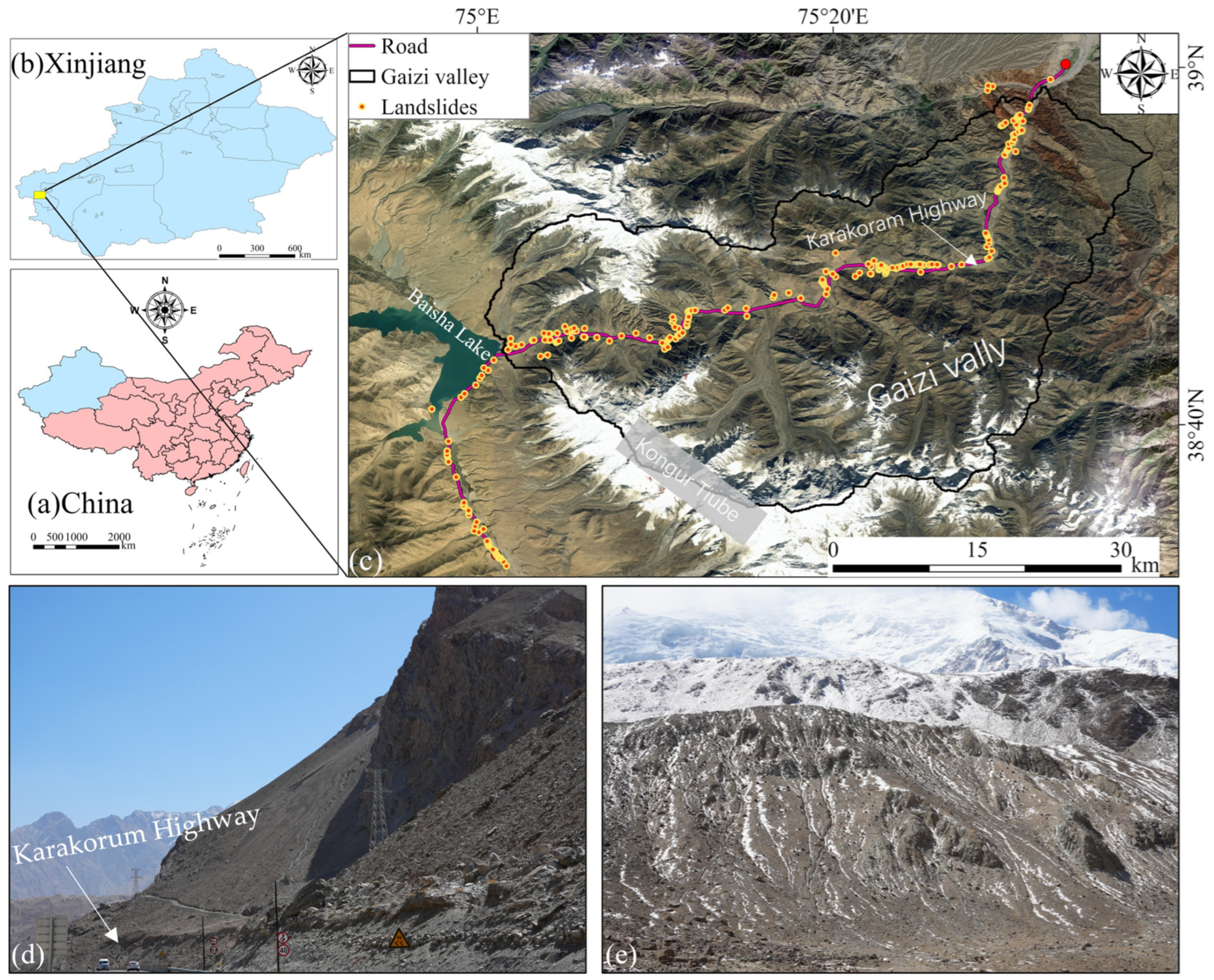


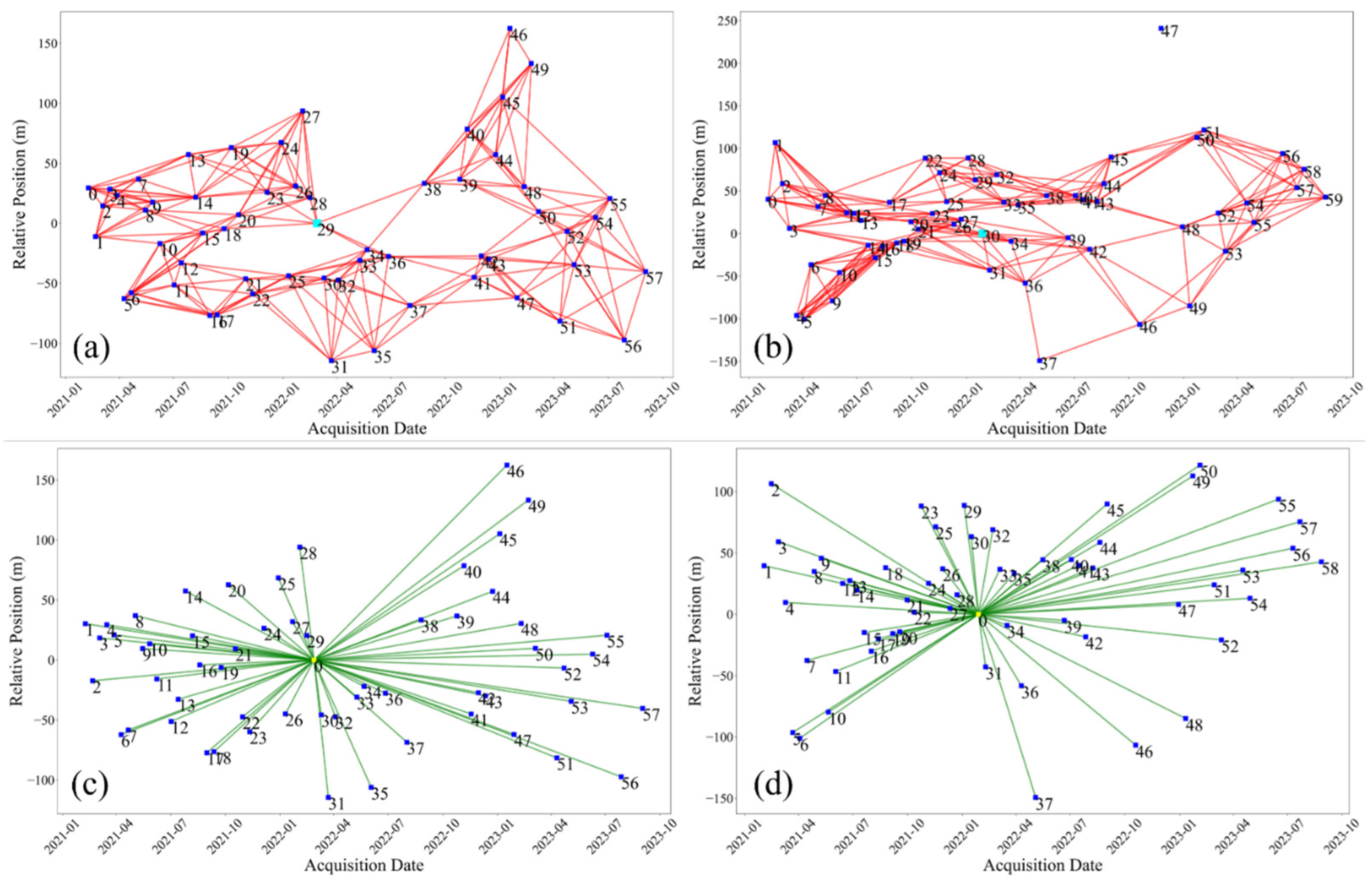



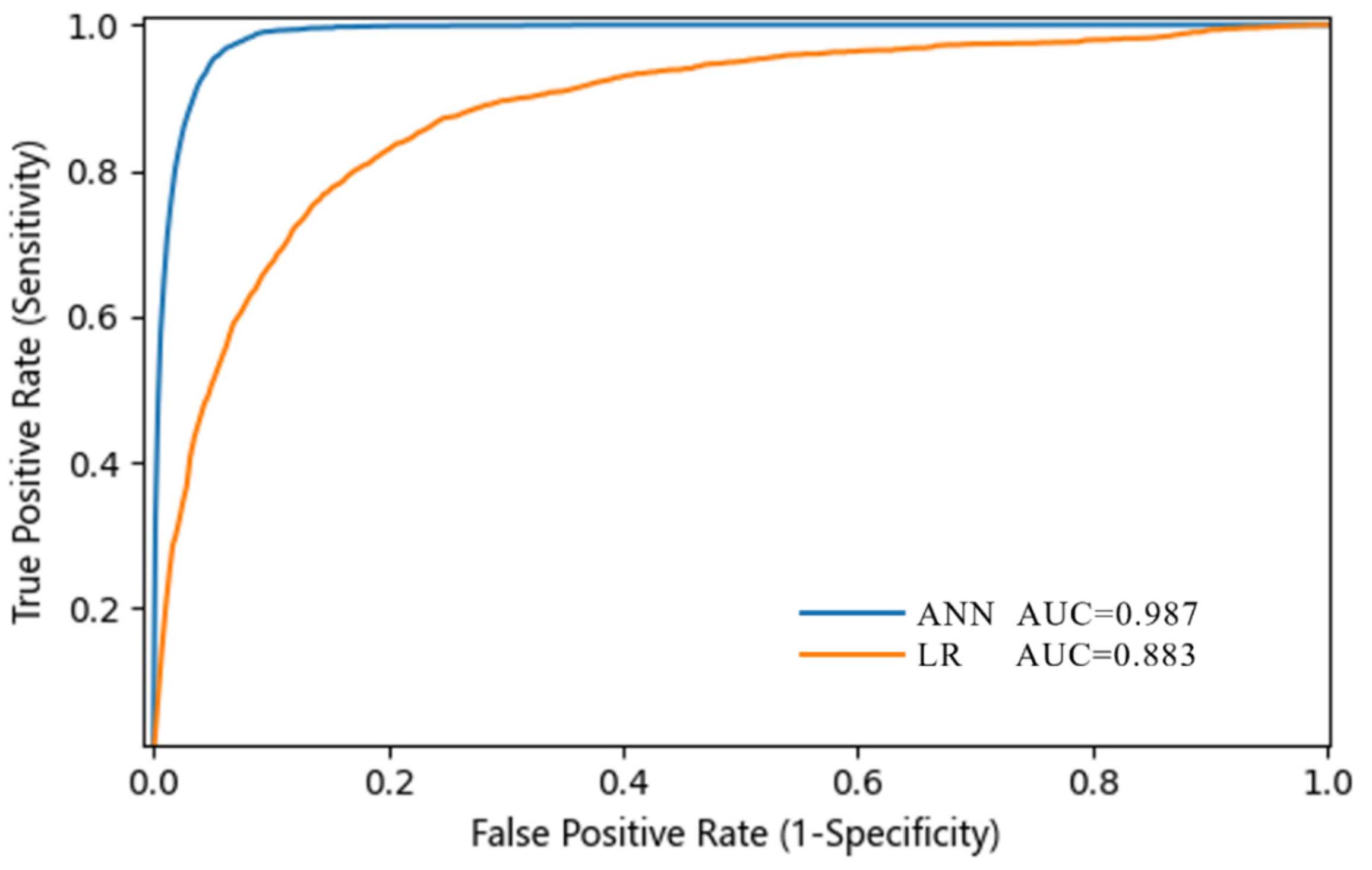
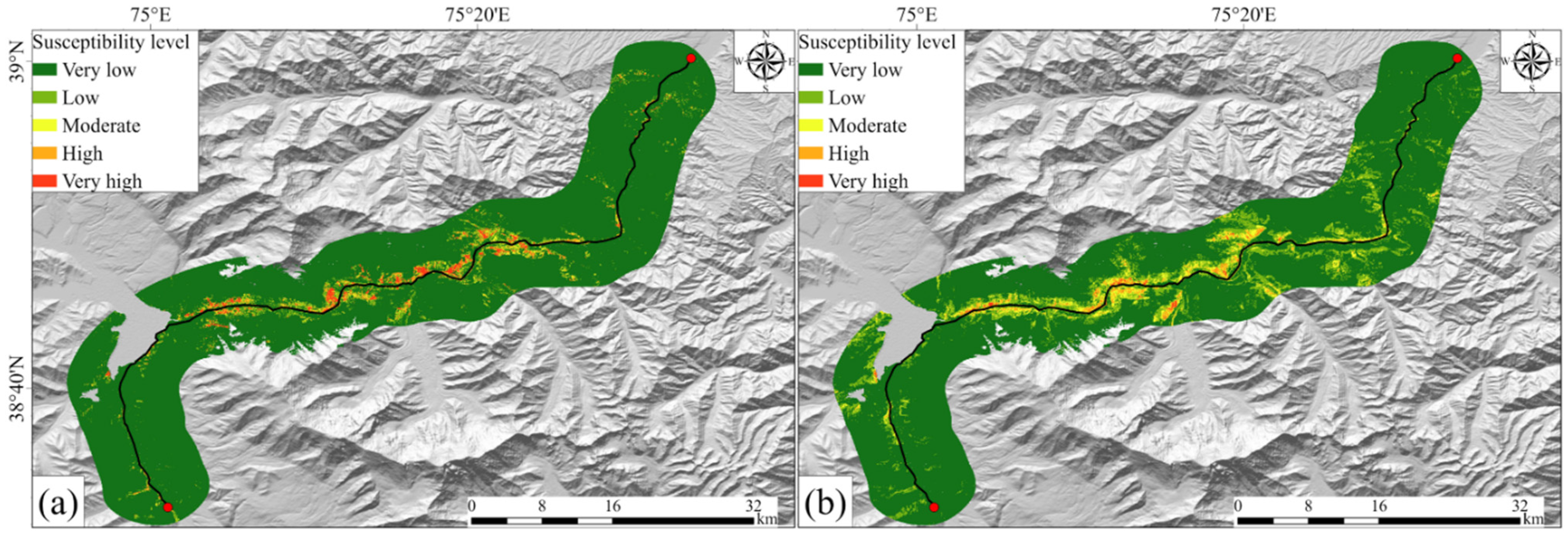

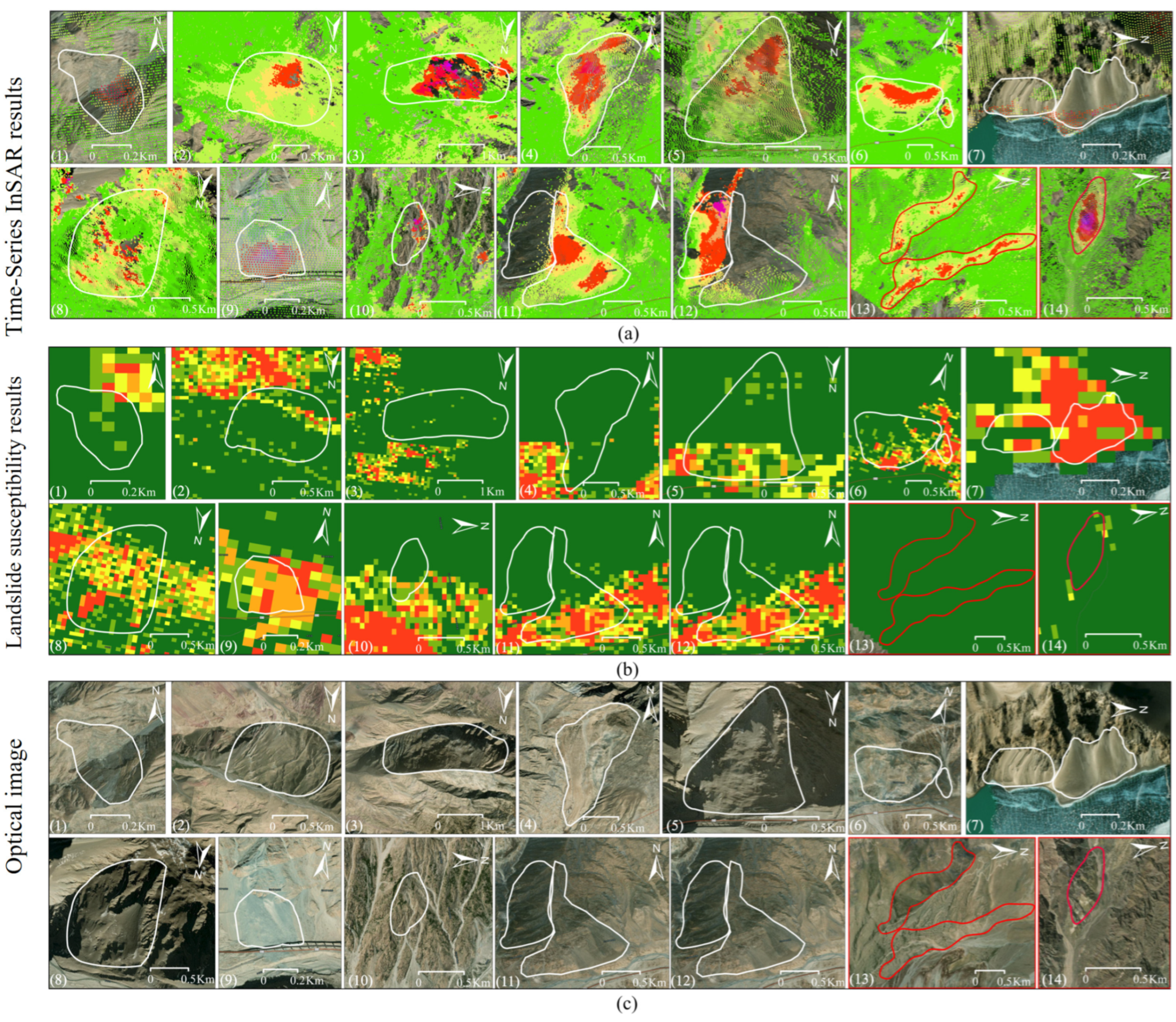
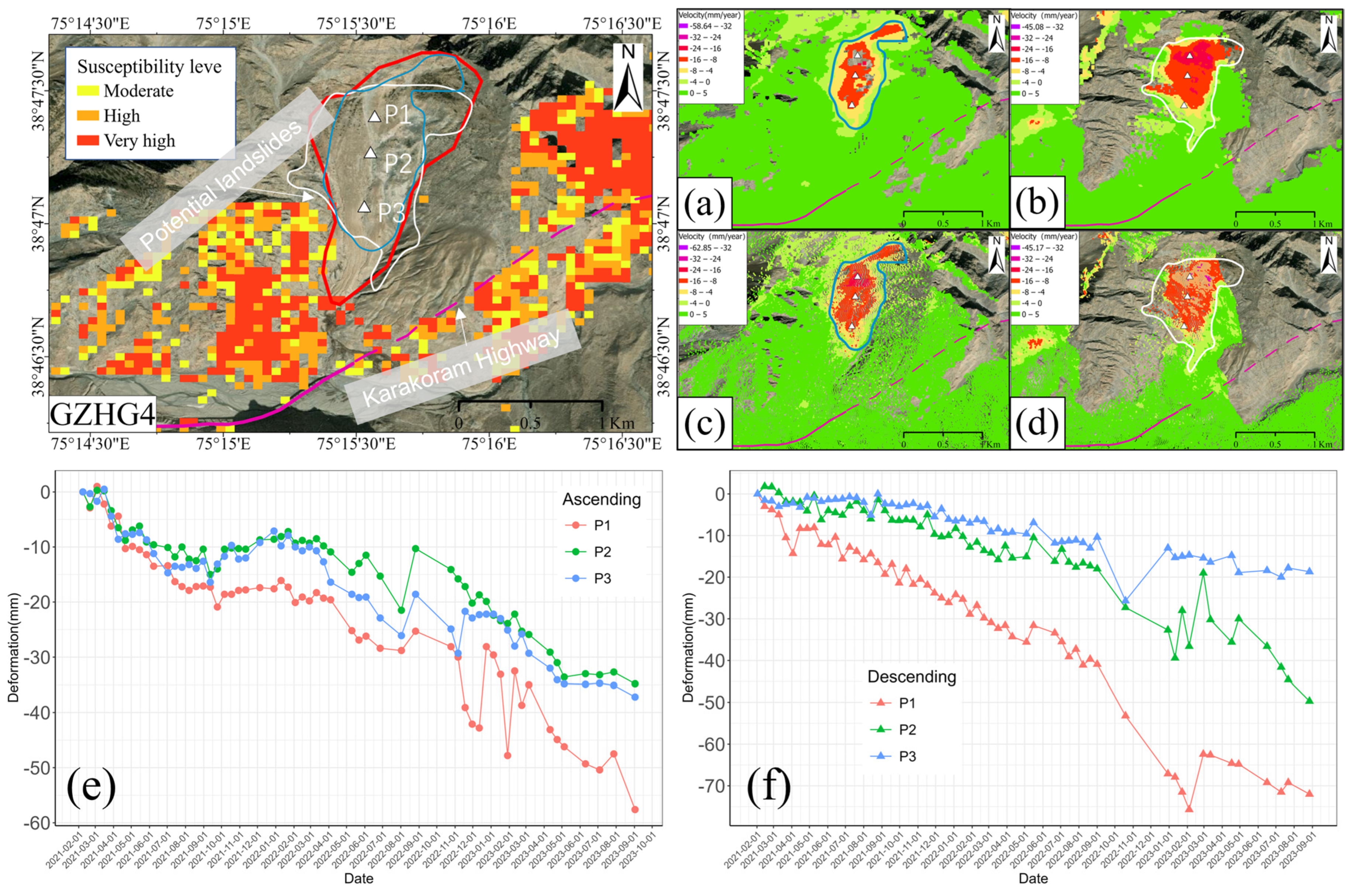
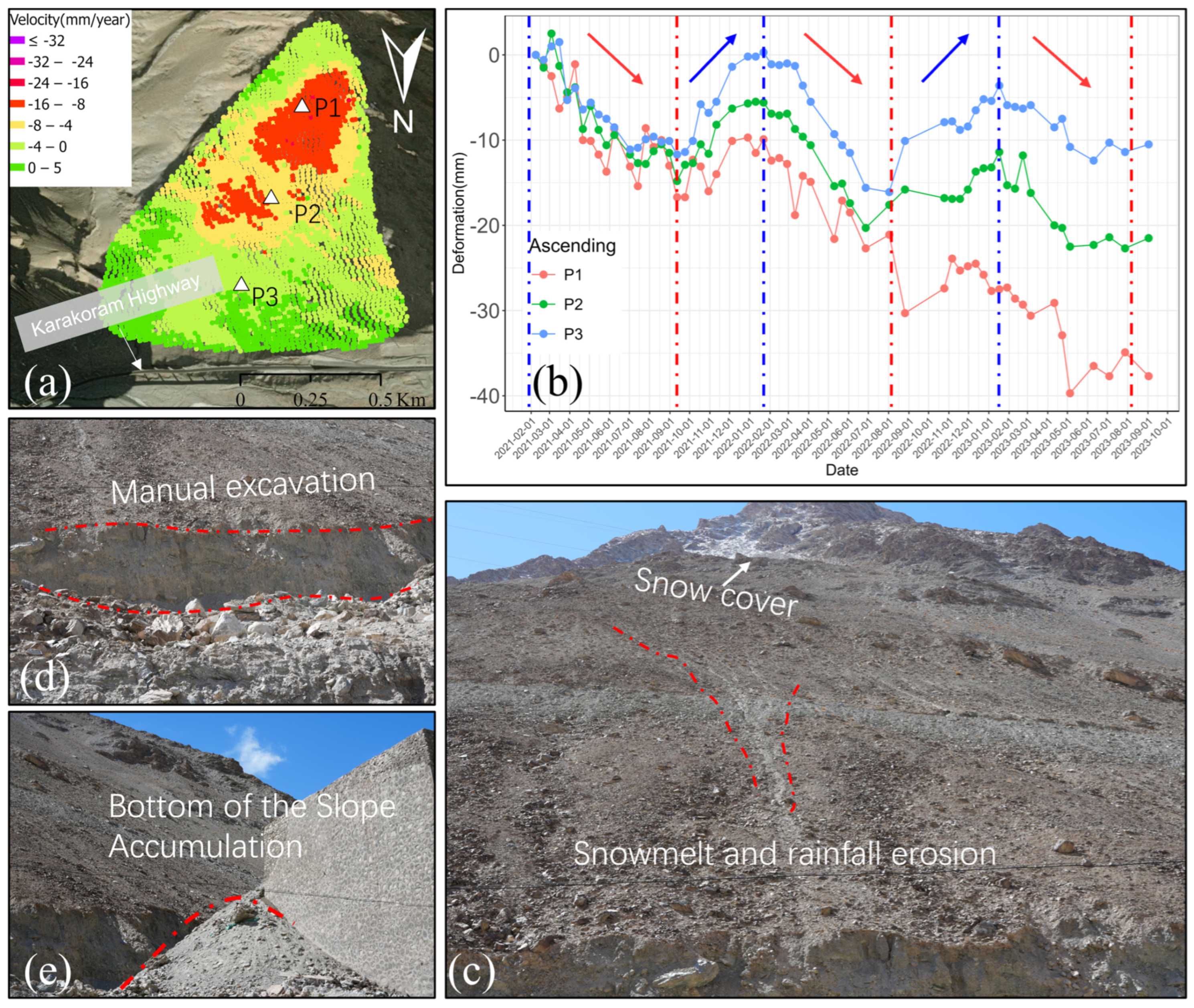
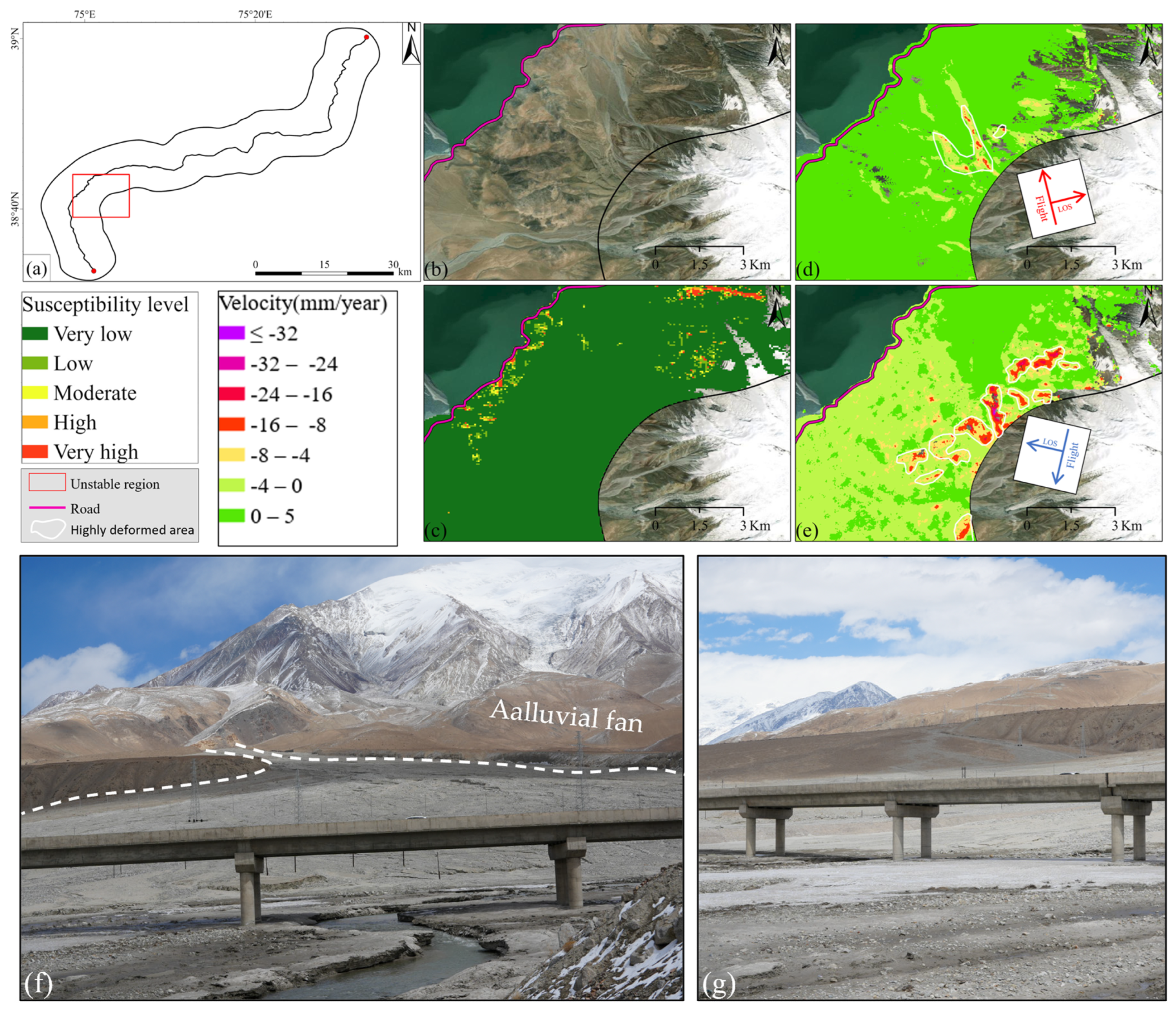

| Orbit | Image Coverage Time | Number of Images | Acquisition Mode | Polarization | Average Incidence Angle |
|---|---|---|---|---|---|
| Ascending | 2021020—20230902 | 58 | IW | VV | 41.03 |
| Descending | 2021020—20230827 | 60 | IW | VV | 35.47 |
| Artificial Intelligence Algorithms | Accuracy | Precision | Recall | F1 Score | Area Under Curve |
|---|---|---|---|---|---|
| LR | 0.801 | 0.868 | 0.711 | 0.768 | 0.883 |
| ANN | 0.916 | 0.936 | 0.892 | 0.934 | 0.987 |
| Model | Very Low | Low | Moderate | High | Very High | |||||
|---|---|---|---|---|---|---|---|---|---|---|
| Area (km2) | Percentage (%) | Area (km2) | Percentage (%) | Area (km2) | Percentage (%) | Area (km2) | Percentage (%) | Area (km2) | Percentage (%) | |
| ANN | 73.25 | 91.78 | 2.92 | 3.67 | 1.46 | 1.83 | 1 | 1.26 | 1.16 | 1.46 |
| LR | 65.95 | 82.62 | 9.68 | 12.13 | 2.78 | 3.48 | 1.23 | 1.54 | 0.19 | 0.23 |
| Number | Longitude | Latitude | Area (km2) | Aspect | Slope (°) | Elevation Difference (m) |
|---|---|---|---|---|---|---|
| GZHG1 | 75.46 | 38.87 | 0.16 | NE | 41.31 | 326 |
| GZHG2 | 75.31 | 38.81 | 3.27 | NE | 35.96 | 1144 |
| GZHG3 | 75.34 | 38.83 | 1.57 | NE | 32.43 | 714 |
| GZHG4 | 75.26 | 38.79 | 1.44 | S | 34.71 | 1139 |
| GZHG5 | 75.25 | 38.77 | 1.05 | NE | 35.83 | 903 |
| GZHG6 | 75.22 | 38.76 | 1.86 | NE | 35.59 | 1105 |
| GZHG7 | 75.21 | 38.77 | 0.13 | SE | 34.37 | 235 |
| GZHG8 | 75.18 | 38.77 | 0.25 | E | 37 | 280 |
| GZHG9 | 75.07 | 38.75 | 1.11 | SE | 40.73 | 1060 |
| GZHG10 | 75.07 | 38.76 | 0.71 | SW | 38.09 | 828 |
| GZHG11 | 75.06 | 38.75 | 0.16 | SE | 43.71 | 335 |
| GZHG12 | 75.05 | 38.75 | 1.96 | SE | 34.88 | 768 |
| BSH1 | 74.96 | 38.68 | 0.08 | E | 32.95 | 71 |
| BSH2 | 74.96 | 38.68 | 0.12 | NE | 45.69 | 239 |
| Orbit | Methods | Number of Unstable Slopes | Number of Common Unstable Slopes | All Unstable Slopes | Potential Landslides |
|---|---|---|---|---|---|
| Ascending | SBAS-InSAR | 44 | 37 | 116 | 14 |
| DS-InSAR | 73 | ||||
| Descending | SBAS-InSAR | 57 | 44 | ||
| DS-InSAR | 77 |
Disclaimer/Publisher’s Note: The statements, opinions and data contained in all publications are solely those of the individual author(s) and contributor(s) and not of MDPI and/or the editor(s). MDPI and/or the editor(s) disclaim responsibility for any injury to people or property resulting from any ideas, methods, instructions or products referred to in the content. |
© 2024 by the authors. Licensee MDPI, Basel, Switzerland. This article is an open access article distributed under the terms and conditions of the Creative Commons Attribution (CC BY) license (https://creativecommons.org/licenses/by/4.0/).
Share and Cite
Lin, K.; Jiapaer, G.; Yu, T.; Zhang, L.; Liang, H.; Chen, B.; Ju, T. Identification of Potential Landslides in the Gaizi Valley Section of the Karakorum Highway Coupled with TS-InSAR and Landslide Susceptibility Analysis. Remote Sens. 2024, 16, 3653. https://doi.org/10.3390/rs16193653
Lin K, Jiapaer G, Yu T, Zhang L, Liang H, Chen B, Ju T. Identification of Potential Landslides in the Gaizi Valley Section of the Karakorum Highway Coupled with TS-InSAR and Landslide Susceptibility Analysis. Remote Sensing. 2024; 16(19):3653. https://doi.org/10.3390/rs16193653
Chicago/Turabian StyleLin, Kaixiong, Guli Jiapaer, Tao Yu, Liancheng Zhang, Hongwu Liang, Bojian Chen, and Tongwei Ju. 2024. "Identification of Potential Landslides in the Gaizi Valley Section of the Karakorum Highway Coupled with TS-InSAR and Landslide Susceptibility Analysis" Remote Sensing 16, no. 19: 3653. https://doi.org/10.3390/rs16193653







